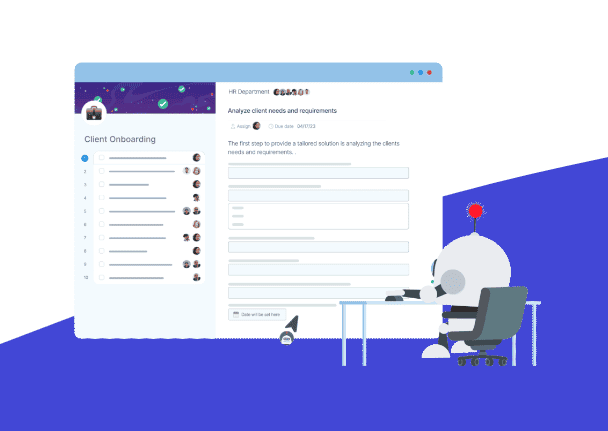Objectives and Key Results (OKRs): A Comprehensive Guide
Have you ever found yourself working incredibly hard on your business but not really making progress towards your big business goals?
You may have been so focused on staying busy that you lost track of what really matters. This was me a few years ago – I was running around like a chicken with my head cut off, doing a million things but not truly focusing on what would really help my business grow.
That’s when I discovered Objectives and Key Results, also known as OKRs. OKRs are a simple yet powerful framework for aligning your teams, setting ambitious goals, and measuring what matters.
In this comprehensive guide, I’ll break down precisely what you need to know about using OKRs so you can start focusing your efforts and supercharging your results.
From setting the right objectives to tracking key results, you’ll leave here with a clear plan of action to help catapult your business to the next level. Let’s dive in!
Short Summary
- Objectives and Key Results (OKRs) is a strategic framework to set & track measurable goals, improve performance, create alignment & foster collaboration.
- OKRs involve setting clear objectives with quantifiable key results that adhere to SMART criteria and involving the team in the goal-setting process.
- Monitoring & evaluating progress quarterly helps identify areas of improvement while avoiding common pitfalls such as unclear objectives or too many objectives.
What are Objectives and Key Results (OKRs)?
OKRs, or Objectives and Key Results, are a strategic framework designed to help organizations set and track measurable goals tied to day-to-day work. This management methodology has gained popularity across various industries for its ability to provide a clear structure and focus on company objectives, improve business performance, and create alignment throughout the entire organization.
At its core, the OKR methodology consists of setting qualitative objectives and quantifiable key results answer, which are used to measure progress toward those objectives. In writing OKRs, it is essential to understand what makes up this robust framework:
- Objectives are qualitative headlines outlining the desired outcome
- Key results are measurable targets to track progress toward achieving those objectives.
By focusing on clear, ambitious annual goals and measurable key results, organizations can unleash the full potential of their teams and drive continuous improvement.
One of the key benefits of the OKR methodology is its adaptability, making it suitable for organizations of all sizes and industries. By implementing OKRs, businesses can ensure that their entire workforce is aligned with the company’s vision and objectives, fostering a culture of transparency and collaboration.
Furthermore, the quarterly cadence of OKRs allows for continuous learning and adjustment, ensuring that organizations remain agile and responsive to changing market conditions.
Objectives
Objectives are qualitative, inspirational goals with a set time frame, typically a quarter, that a team or individual must achieve.
Think of an objective as a “strategic theme” – a broad, overarching, qualitative headline of the desired outcome that inspires and motivates your team. Balancing ambitious and achievable objectives is essential to ensure that your team stays engaged and focused on delivering results.
A critical aspect of setting objectives is ensuring they contribute to the organization’s overall organizational strategy and foster cross-functional collaboration. By crafting objectives that span multiple departments, each team within the organization can contribute to the overarching goal, promoting a culture of collaboration and shared ownership.
There are three primary types of objectives: building, improving, and innovating. Understanding and aligning these types with your organization’s goals can create a roadmap for success.
While objectives provide the big picture, key results are the measurable metrics that indicate whether an objective has been achieved. It’s important to understand the distinction between objectives and key results to ensure that you write OKRs that are both motivational and measurable.
Objectives outline the desired direction, while key results share the same characteristics as SMART goals (specific, measurable, achievable, relevant, and time-bound).
Key Results
Key Results (KR) are quantifiable outcomes necessary to achieve the Objective, breaking down the OKR’s objective into specific metrics to measure progress.
Key Results encompass the same attributes as SMART goals (specific, measurable, achievable, relevant, and time-bound) and must include a start and target value. By setting clear, measurable targets, you can effectively track progress and ensure that your team remains focused on achieving OKRs.
Google, a prime example of a company that has thrived using OKRs, maintains that “a Key Result must include a numerical value to be valid.” This principle shows why you need to set quantifiable targets to measure progress accurately. By defining specific metrics and targets, you can avoid ambiguity and ensure that your team knows exactly what success looks like.
The team member assigned the goal is responsible for the corresponding Key Result. This Key Result can only be updated by the individual responsible for the goal that it is measuring.
By assigning ownership of key results, you can empower your team members to take responsibility for their contributions, fostering a culture of accountability and continuous improvement. In turn, this sense of ownership helps drive the success of your OKR program.
The Origins of OKRs
While the concept of OKRs may seem relatively new, its roots can be traced back to 1954 with Peter Drucker’s Management by Objectives (MBO) approach. The OKR methodology, as we know it today, was developed by Andrew Grove at Intel in the 1970s. Grove’s goal was to communicate his objectives to teams across the globe effectively, reach consensus on ambitious objectives, and implement them with a high degree of focus and alignment.
John Doerr, a former Intel employee and venture capitalist, introduced the OKR methodology to Google’s founders, Larry Page and Sergey Brin, in the late 1990s. Since then, Google has attributed much of its success to implementing OKRs, which has helped the company maintain its focus and agility as it has grown into the tech giant it is today.
The success of OKRs at Google has inspired countless other organizations worldwide to adopt the methodology for setting and tracking ambitious objectives. Today, companies like Allbirds, Zume Pizza, Apple, and Netflix have all achieved remarkable success by implementing OKRs.
Types of OKRs and Their Applications
As you begin exploring the world of OKRs, you’ll likely encounter various types, each with unique applications and benefits. Committed, aspirational, and learning OKRs are the three primary types of OKRs, each designed to address different organizational needs and goals.
- Committed OKRs are promises that individuals make to themselves. As their name implies, they must be kept. At the end of a cycle, a committed OKR is anticipated to achieve a passing grade, ensuring that your team remains focused on delivering results.
- Aspirational OKRs, also known as stretch goals, involve shooting for the same objective that has not been achieved before. These objectives may be long-term, going beyond an OKR cycle, or being transferred between team members to increase engagement.
- Learning OKRs are used when the most valuable outcome of a cycle is gaining new knowledge. If a team is uncertain of the best approach, they may set a learning OKR that asks, “What is the most significant thing we are trying to learn in the next 90 days?” The results can be valuable for setting up new OKRs for the next cycle.
Understanding the different types of OKRs and their applications can help you tailor your approach to goal-setting, ensuring that your organization effectively addresses its unique needs and objectives. By selecting the appropriate type of OKR for each situation, you can maximize the benefits of this robust goal-setting methodology.
Establish Effective OKRs
Establishing effective OKRs is crucial to the success of any OKR program. Setting clear, ambitious, and inspirational objectives is the first step in creating an effective OKR. Focusing on your organization’s most critical goals ensures that your team remains engaged and motivated to deliver results.
Measurable outcomes are key for effective OKRs. This is where key results come into play, providing quantifiable targets to track progress toward the objectives. To develop effective key results, identify the metrics to measure progress toward your objectives and establish realistic and achievable targets. By defining and tracking key results, you can effectively measure progress and ensure that your team remains focused on achieving the desired outcomes.
When creating OKRs, adhering to the SMART criteria (Specific, Measurable, Achievable, Relevant, and Time-bound) is essential. By setting objectives and key results that meet these criteria, you can ensure that your OKRs are motivational and measurable. Aligning your OKRs with the SMART criteria helps drive focus, clarity, and accountability throughout your organization.
In addition to following the SMART criteria, involving your entire team in the goal-setting process is important. Communicate the objectives and key results clearly and ensure each team member understands their role in achieving the desired outcomes. This collaborative approach fosters a culture of shared ownership and accountability, ultimately contributing to the success of your OKR program.
Implement OKRs in Your Organization
Successfully implementing OKRs in your organization requires a well-planned approach and strong leadership support. Getting your leadership onboard is vital to ensure that the OKR program is thoroughly endorsed and that all parties agree with the objectives and key results. To be successful, appoint someone on the leadership team responsible for training and supporting participants in the OKR program.
Design your OKR program to focus on at most three objectives with key results for each. Limiting the number of objectives allows you to maintain focus and ensure that your team’s efforts are concentrated on the most critical goals. Implementing OKRs at both the company and team levels can help create alignment and foster a sense of shared ownership.
Regularly reviewing your OKRs are essential to ensure that progress is being made and adjustments are made as necessary. Establish a system to monitor progress and periodically review the objectives and key results. By continuously tracking and evaluating the performance of your OKRs, you can drive continuous improvement and ensure that your business stays on track toward achieving its goals.
Monitor and Evaluate OKRs
Regularly monitoring and evaluating your OKRs are critical to your success. Consistent tracking enables your organization to identify areas of improvement, make necessary adjustments, and celebrate your team’s achievements. Several grading methods can be used to assess the performance of OKRs, including the Andy Grove method of “yes” or “no,” the “Red, Yellow, Green” system, and Google’s percentage scale.
In addition to establishing a grading system, it’s crucial to review OKRs on a quarterly basis for optimal results. This regular review process allows your organization to assess progress, identify areas of improvement, and make necessary adjustments to keep your team on track toward achieving its objectives.
To help you stay on top of tracking OKRs, many tools and resources are available, such as ClickUp or Notion. By leveraging these tools, you can streamline the monitoring and evaluation process, ensuring that your team remains focused on achieving its objectives and delivering results.
OKR Success Stories
Many organizations have successfully adopted the OKR methodology, demonstrating its effectiveness in driving growth and performance. Companies such as Allbirds, Zume Pizza, Apple, and Netflix have all achieved remarkable success by implementing OKRs. These success stories highlight the power of OKRs in driving organizational alignment, focus, and, ultimately, growth.
Google’s success with OKRs is the most well-known example, as the company has attributed much of its growth and innovation to the implementation of OKRs. Google’s founders, Larry Page and Sergey Brin, were introduced to OKRs by John Doerr and have since implemented the methodology throughout the organization, helping the tech giant maintain focus and agility in a rapidly evolving industry.
These stories serve as powerful examples of how OKRs significantly impact business performance. By effectively embracing and implementing the OKR methodology, you can unlock your full potential and achieve remarkable growth and success.
Avoiding Common OKR Pitfalls
While the benefits of OKRs are well-documented, you should be aware of pitfalls and common OKR mistakes when crafting and implementing OKRs. One common misstep is setting too many objectives, which can dilute focus and hinder progress. Limiting the number of objectives ensures that your team remains focused on the most critical goals.
Another common mistake is not quantifying OKRs or linking them to daily work. To avoid these pitfalls, ensure that your objectives are clear, ambitious, and inspirational and that your key results provide measurable outcomes that are directly tied to the work your team is doing.
OKRs vs. KPIs: Understanding the Difference
While both OKRs and Key Performance Indicators (KPIs) play crucial roles in organizational goal-setting, it’s essential to understand the differences. The OKR framework is strategically designed to help organizations set and track measurable goals, while KPIs are metrics used to monitor and evaluate the progress of business operations over time.
One key difference between the two is their respective focuses. OKRs emphasize setting ambitious objectives and identifying the key results that will measure progress toward those objectives.
In contrast, KPIs focus on tracking the performance of specific organizational processes or functions. However, despite their differences, KPIs can be used as key results in OKRs, demonstrating the complementary nature of these two goal-setting approaches.
By understanding the differences between OKRs and KPIs, you can effectively leverage both methodologies to drive your organization’s growth and performance. Utilizing OKRs to set ambitious objectives and KPIs to track progress helps create a comprehensive and robust goal-setting strategy that can propel your organization to new heights.
Tools and Resources for Managing OKRs
Managing OKRs effectively requires the right tools and resources. Numerous software solutions are available to help you track and evaluate your OKRs, including ClickUp, Notion, and more. These tools provide a centralized platform for setting, tracking, and evaluating OKRs, helping to ensure that your team remains focused on achieving its objectives.
In addition to software solutions, various publications can provide valuable insights and guidance on implementing OKRs in your organization. Books such as “Measure What Matters” by John Doerr and “Radical Focus” by Christina Wodtke can help you craft and implement effective OKRs, helping you unlock your organization’s full potential.
By leveraging the right tools and resources, you can streamline the OKR management process and ensure that your organization remains focused on achieving its ambitious goals. With the proper support, your team can effectively navigate the challenges of OKR implementation and drive your organization toward success.
Final Thoughts on OKRs
In conclusion, OKRs are a robust goal-setting methodology that can transform how your organization sets, tracks, and achieves its objectives. By understanding the components of OKRs, their origins, and the various types and applications, your organization can unlock its full potential and drive remarkable growth.
Crafting effective OKRs, implementing them in your organization, and monitoring progress are essential steps to ensuring the success of your OKR program. Thus, you should embrace the power of OKRs and unlock the full potential of your team.
Setting clear, ambitious objectives and measurable vital results can propel your organization to new heights and achieve unprecedented success.
The journey toward organizational excellence starts with a single step – are you ready to take it?
Frequently Asked Questions
What do you mean by OKRs?
Objectives and key results, or OKRs, is a goal-setting methodology that helps individuals and teams set measurable objectives and track progress towards them. OKRs provide an effective way of ensuring everyone in the organization is on the same page, working towards the same goals, and helping to drive organizational alignment.
What is an example of an Objective and Key Results (OKRs)?
An example of an OKR is ‘Increase website visits by 25%’ as the objective, with key results including increasing organic traffic by 15%, boosting social media followers by 10%, and gaining 100 new email subscribers.
What is the difference between OKRs and KPIs?
The key difference between OKRs and KPIs is that the former focuses on setting company goals and objectives, while the latter measures progress against those goals.
OKRs provide a company with vision and direction, while KPIs give the team insight into how well they achieve their goals. Both approaches can be used together to ensure success.
What are example applications of OKRs?
Setting objectives and key results using OKRs is an effective way for organizations to track progress toward their long-term goals. Team-specific OKR examples include developing new products, expanding into new markets, driving customer satisfaction, and increasing revenue.
With these objectives and measurable key results, organizations can drive team and company success.







